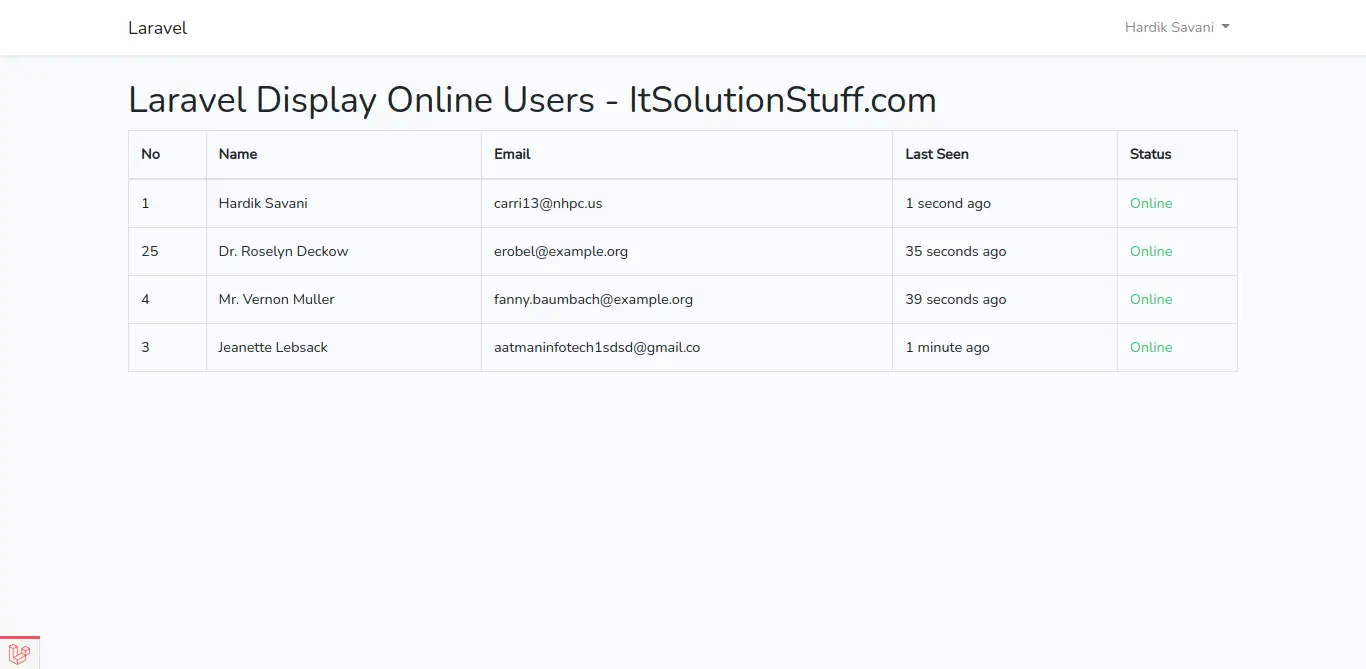How to Get Online Users in Laravel?
Hello Dev,
Today, i would like to show you how to get online users in laravel. We will look at example of laravel get all logged in users. you will learn laravel check user online. We will use laravel get online users. Let's get started with laravel check if user is online or not.
In this tutorial, i will give you simple example of how to get all online users with last seen time in laravel. you can easily use this example with laravel 6, laravel 7, laravel 8, laravel 9, laravel 10 and laravel 11 version.
Here, we will add new column "last_seen" in users table and create new middleware for web that will check if user login then it will update last_seen time and add key for online in cache, so we can check user online or not using that. so just follow bellow step and make it done now as like bellow screen shot:
Preview:

Step 1: Install Laravel
first of all we need to get fresh Laravel 8 version application using bellow command, So open your terminal OR command prompt and run bellow command:
composer create-project --prefer-dist laravel/laravel blog
Step 2: Add New Column to Users Table
here, we will create new migration for adding "last_seen" column:
php artisan make:migration add_new_column_last_seen
database/migrations/2021_07_12_032305_add_new_column_last_seen.php
<?php
use Illuminate\Database\Migrations\Migration;
use Illuminate\Database\Schema\Blueprint;
use Illuminate\Support\Facades\Schema;
class AddNewColumnLastSeen extends Migration
{
/**
* Run the migrations.
*
* @return void
*/
public function up()
{
Schema::table('users', function(Blueprint $table){
$table->timestamp('last_seen')->nullable();
});
}
/**
* Reverse the migrations.
*
* @return void
*/
public function down()
{
}
}
now let's run migration command:
php artisan migrate
now, just add last_seen column on user model as like bellow:
app/Models/User.php
<?php
namespace App\Models;
use Illuminate\Contracts\Auth\MustVerifyEmail;
use Illuminate\Database\Eloquent\Factories\HasFactory;
use Illuminate\Foundation\Auth\User as Authenticatable;
use Illuminate\Notifications\Notifiable;
class User extends Authenticatable
{
use HasFactory, Notifiable;
/**
* The attributes that are mass assignable.
*
* @var array
*/
protected $fillable = [
'name', 'email', 'password', 'last_seen'
];
/**
* The attributes that should be hidden for arrays.
*
* @var array
*/
protected $hidden = [
'password', 'remember_token',
];
/**
* The attributes that should be cast to native types.
*
* @var array
*/
protected $casts = [
'email_verified_at' => 'datetime',
];
}
Step 3: Generate Auth Scaffolding
here, we will use laravel ui for generating auth scaffolding, so let's run bellow command:
composer require laravel/ui --dev
after installing composer package, run bellow command:
php artisan ui bootstrap --auth
now, run npm install commands:
npm i && npm run dev
Step 4: Create Middleware
here, we will create UserActivity for update last seen time and add online status, let's run bellow command:
php artisan make:middleware UserActivity
now, update middleware code as bellow:
app/Http/Middleware/UserActivity.php
<?php
namespace App\Http\Middleware;
use Closure;
use Illuminate\Http\Request;
use Auth;
use Cache;
use App\Models\User;
class UserActivity
{
/**
* Handle an incoming request.
*
* @param \Illuminate\Http\Request $request
* @param \Closure $next
* @return mixed
*/
public function handle(Request $request, Closure $next)
{
if (Auth::check()) {
$expiresAt = now()->addMinutes(2); /* keep online for 2 min */
Cache::put('user-is-online-' . Auth::user()->id, true, $expiresAt);
/* last seen */
User::where('id', Auth::user()->id)->update(['last_seen' => now()]);
}
return $next($request);
}
}
now register, this middleware to kernel file:
app/Http/Kernel.php
<?php
namespace App\Http;
use Illuminate\Foundation\Http\Kernel as HttpKernel;
class Kernel extends HttpKernel
{
...........
protected $middlewareGroups = [
'web' => [
\App\Http\Middleware\EncryptCookies::class,
\Illuminate\Cookie\Middleware\AddQueuedCookiesToResponse::class,
\Illuminate\Session\Middleware\StartSession::class,
\Illuminate\View\Middleware\ShareErrorsFromSession::class,
\App\Http\Middleware\VerifyCsrfToken::class,
\Illuminate\Routing\Middleware\SubstituteBindings::class,
\App\Http\Middleware\RestrictIpAddressMiddleware::class,
\App\Http\Middleware\UserActivity::class,
],
'api' => [
'throttle:api',
\Illuminate\Routing\Middleware\SubstituteBindings::class,
],
];
...........
}
Step 5: Create Route
In this is step we need to create some routes for display online users function.
routes/web.php
<?php
use Illuminate\Support\Facades\Route;
use App\Http\Controllers\UserController;
/*
|--------------------------------------------------------------------------
| Web Routes
|--------------------------------------------------------------------------
|
| Here is where you can register web routes for your application. These
| routes are loaded by the RouteServiceProvider within a group which
| contains the "web" middleware group. Now create something great!
|
*/
Route::get('/', function () {
return view('welcome');
});
Auth::routes();
Route::get('/home', [App\Http\Controllers\HomeController::class, 'index'])->name('home');
Route::get('online-user', [UserController::class, 'index']);
Step 6: Create Controller
in this step, we need to create UserController and add following code on that file:
app/Http/Controllers/UserController.php
<?php
namespace App\Http\Controllers;
use Illuminate\Http\Request;
use App\Models\User;
class UserController extends Controller
{
/**
* Display a listing of the resource.
*
* @return \Illuminate\Http\Response
*/
public function index(Request $request)
{
$users = User::select("*")
->whereNotNull('last_seen')
->orderBy('last_seen', 'DESC')
->paginate(10);
return view('users', compact('users'));
}
}
Step 7: Create Blade Files
here, we need to create blade files for users. so let's create one by one files:
resources/views/users.blade.php
@extends('layouts.app')
@section('content')
<div class="container">
<h1>Laravel Display Online Users - ItSolutionStuff.com</h1>
<table class="table table-bordered data-table">
<thead>
<tr>
<th>No</th>
<th>Name</th>
<th>Email</th>
<th>Last Seen</th>
<th>Status</th>
</tr>
</thead>
<tbody>
@foreach($users as $user)
<tr>
<td>{{ $user->id }}</td>
<td>{{ $user->name }}</td>
<td>{{ $user->email }}</td>
<td>
{{ Carbon\Carbon::parse($user->last_seen)->diffForHumans() }}
</td>
<td>
@if(Cache::has('user-is-online-' . $user->id))
<span class="text-success">Online</span>
@else
<span class="text-secondary">Offline</span>
@endif
</td>
</tr>
@endforeach
</tbody>
</table>
</div>
@endsection
Now we are ready to run our example and login with user. so run bellow command so quick run:
php artisan serve
Now you can open bellow URL on your browser:
localhost:8000/online-user
i hope it can help you...

